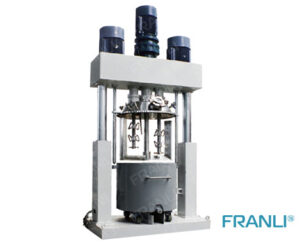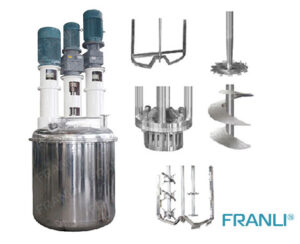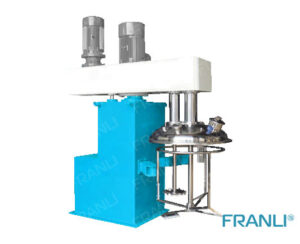Home » Multi-Shaft Mixers|Industrial Mixers
Multi-Shaft Mixers|Industrial Mixers
Multi Shaft Mixers
Multi-shaft mixers are industrial mixing machines that are used across various industries for mixing, blending, and dispersing a wide range of materials. They are commonly used in industries such as food processing, chemicals, pharmaceuticals, plastics, and more. Multi-shaft mixers feature two or more independently driven mixing shafts that rotate at different speeds to thoroughly blend materials together. Their multi-shaft design allows for superior mixing performance compared to single-shaft mixers.
Advantages of Multi-Shaft Mixer
- Which can mix the material ≤1,000,000 cps, stronger power, fully mixing high viscosity.
- The Teflon scrapper on the low speed (butterfly mixer), scraping the wall of the tank also bottom of the tank.
- The stainless steel round cover with vacuum system, to remove the foam and air, sight view glass, feeding system hole.
Application: Paint, Adhesive, Battery, Pharmaceutical industry, Cosmetic
Multi-shaft mixers are versatile and essential tools used in a wide range of industries, offering efficient and uniform mixing, dispersion, and emulsification capabilities. Their ability to handle high-viscosity materials and diverse formulations makes them valuable for the production of a wide array of products across different sectors.
How Multi-Shaft Mixers Work
Multi-shaft mixers work by using two or more shafts fitted with mixing elements like paddles, blades, or ribbons that rotate inside a mixing vessel or container. The shafts are powered independently by separate motors and gearboxes so they can rotate at different speeds. This differential motion of the shafts creates a complex motion profile within the mixing chamber that subjects the materials to both shear and compression forces.
The interaction between the rotating shafts and their mixing elements thoroughly blends the materials by folding and refolding them over and over again. This repeated folding action exposes all particles to shearing and ensures an even distribution of ingredients throughout the mixture. It also helps to de-agglomerate powders, disperse liquids, and develop homogeneity at a much faster rate than single-shaft mixers.
Some key benefits of using multi-shaft mixers
– Superior blending – The differential motion of multiple shafts results in a folding action that provides an extremely high degree of blending compared to single-shaft mixers.
– Shorter mixing cycles – Materials reach homogeneity quicker due to the intense shearing and folding action inside the mixing chamber.
– Gentler mixing – Lower shaft speeds can be used since differential motion does the work, reducing damage to heat-sensitive materials.
– Scalable designs – Multi-shaft mixers are available in a wide range of sizes from lab to production scales.
– Versatile applications – Suitable for mixing virtually any free-flowing or viscous materials like liquids, pastes, doughs, slurries, and more.
– Self-cleaning effect – The opposing rotation of shafts helps to scrape materials off the vessel walls for a self-cleaning action.
Types of Multi-Shaft Mixers
There are different types of multi-short mixers available depending on the specific mixing application and throughput requirements. Some common varieties include:
– Planetary Mixers – Feature an outer stationary vessel and an inner shaft that rotates along with independently driven planetary mixing arms. Ideal for high-shear mixing of viscous materials.
– Ribbon Blenders – Equipped with vertically or horizontally oriented ribbon-style mixing elements on two or more counter-rotating shafts. Effective for free-flowing dry and liquid ingredients.
– Sigma Blade Mixers – Utilize two or more shafts fitted with paddle-style sigma blades. Suitable for a wide range of low to high-viscosity wet and dry materials.
– Double Planetary Mixers – Incorporate two sets of independently driven planetary mixing arms in a single vessel. Provide an extremely intense mixing action.
– Plowshare Mixers – Equipped with horizontal plowshare-style mixing elements on counter-rotating shafts. Commonly used in food processing applications.
– Screw Mixers – Feature co-rotating or counter-rotating intermeshing screw elements. Effective for continuous mixing of bulk materials.
Key Components of Multi-Shaft Mixers
All multi-shaft mixers share some common key components that work together to provide superior mixing performance:
– Mixing Shafts – Made of corrosion-resistant stainless steel or other alloys. The number and configuration depend on the mixer design.
– Mixing Elements – Come in various shapes like paddles, ribbons, blades, or plowshares. Attach to shafts to impart motion.
– Drive Motors – Provide power to turn shafts individually. Can be electric, pneumatic, or hydraulic.
– Gearboxes – Connected between motors and shafts to reduce speeds and increase torque as needed.
– Mixing Chamber – Vessel where materials are blended. Made of stainless steel, plastic, alloy, or rubber lined.
– Support Frame – Robust frame to house all components. May include legs or mounts for stationary or portable use.
– Controls – PLC or touchscreen for automated operation, speed settings, and safety features.
– Discharge Doors – For easy loading/unloading at the bottom or sides of the vessel.
Applications of Multi-Shaft Mixers
Given their versatility and superior mixing capabilities, multi-shaft mixers find wide application across many industries for various mixing tasks:
Food Processing:
– Dough mixing for bread, pizza, pastries
– Batter mixing for pancakes, waffles, batters
– Filling mixing for snacks, desserts
– Sauce and condiment mixing
Chemicals:
– Liquid-liquid mixing
– Liquid-powder slurry preparation
– Pigment dispersion
– Solvent blending
Pharmaceuticals:
– API wet granulation
– Cream and ointment preparation
– Suspension, emulsion, and solution mixing
Plastics:
– Colorant dispersion in polymers
– Compound preparation
– Additive blending
– Recycling and reprocessing
Cosmetics:
– Cream, lotion, and gel formulation
– Makeup and colorant blending
– Shampoo and hair product mixing
And many other industries like mining, ceramics, paints, laboratory R&D, and more. Multi shaft mixers are highly versatile machines suitable for a wide range of mixing applications.
Multi-shaft mixers offer superior blending performance compared to single-shaft mixers due to their unique differential motion mixing principle. The interaction between multiple independently driven shafts subjects materials to intense shearing and folding actions for thorough and rapid blending. They are highly versatile machines suitable for both continuous and batch mixing of virtually any free-flowing or viscous materials across many industries. Key benefits include shorter mixing cycles, gentler handling, self-cleaning effects, and scalability. Overall, multi-shaft mixers provide an efficient and effective solution for rigorous mixing tasks.
Welcome to send inquiry to us and let’s make a win win business together !
Guidelines For Multi Shaft Mixer
FRANLI customized different kinds of multi-shaft mixers for more than 300+ customers. This kind of machine works in the coating industry, medicine industry, cosmetic industry, and other high technology chemical industries.

The Application of Triple Shaft Mixers in Adhesives
Triple-shaft mixers, also known as multi-shaft mixers, are innovative blending machines designed to efficiently mix and disperse various components in adhesives.

Triple Shaft Mixer: Ideal Equipment for Ink Production
Triple shaft mixers are capable of handling a wide range of ink formulations, including solvent-based, water-based, UV-curable, and hybrid inks.

The Versatility and Application of Triple Shaft Mixers in Coatings
Triple shaft mixers have revolutionized the coating industry by providing efficient and versatile solutions for mixing raw materials.

What is a Multi-Shaft Mixer?
A multi-shaft mixer is a type of industrial mixer that has more than one mixing shaft. These mixers are designed to mix multiple ingredients simultaneously, allowing for more efficient and effective mixing.

Dual Shaft Mixer – Dispersion & Stirring
The dual shaft mixer is the best mixer to dissolve the specific ingredients with appropriate shear capacity. This activity is performed by the high-speed shafts situated in the mixer and provides you with the perfect uniformity of the product. It also contains an Anchor agitator and a High-Speed Disperser that offer you the best quality and consistency.

Triple Shaft Mixer | anchor type, butterfly type & frame type
The FRANLI triple shaft mixer extends the working area by adding a rotating stator mixer with a large displacement or a second quick distributor. High shear stator and rotary mixer can emulsify and homogenize products that require higher shear forces to reduce particles into smaller sizes.

